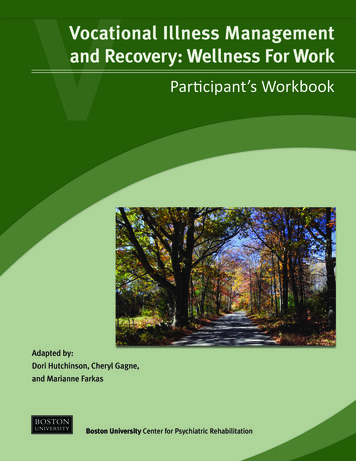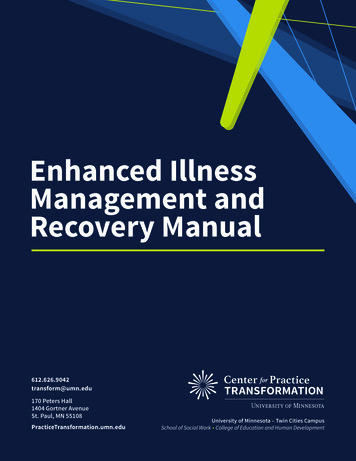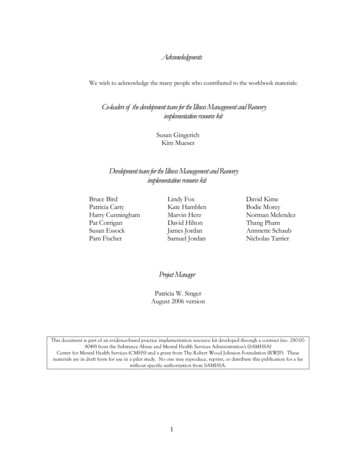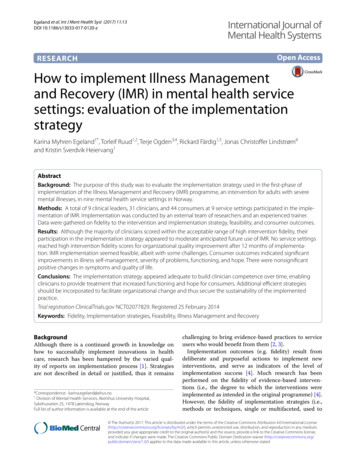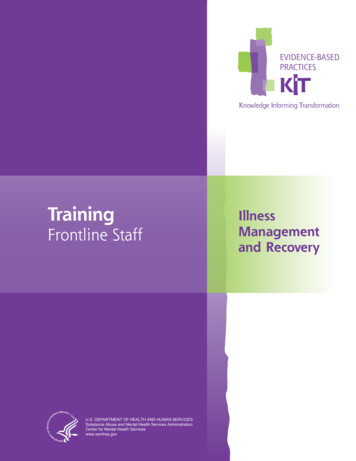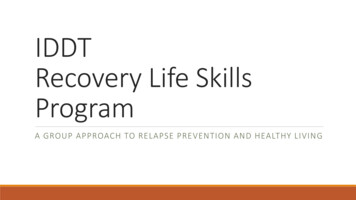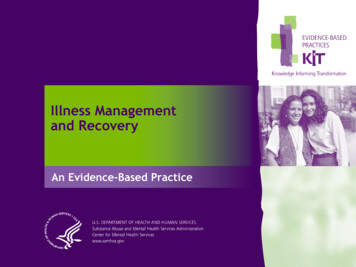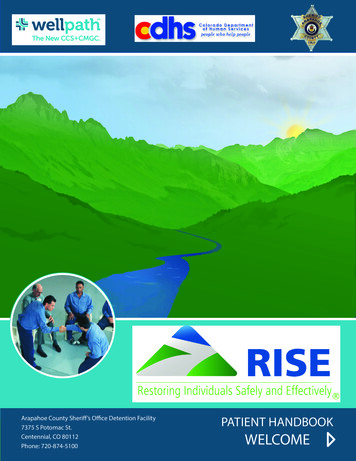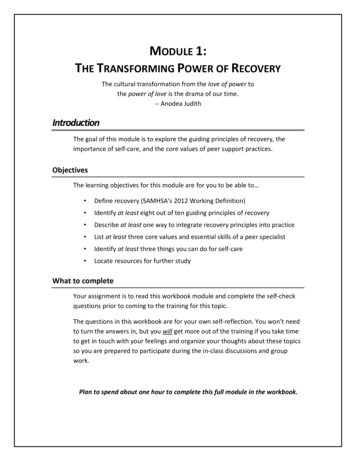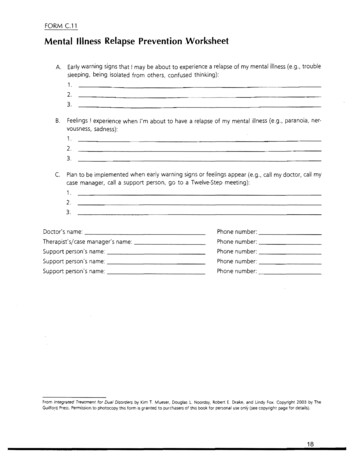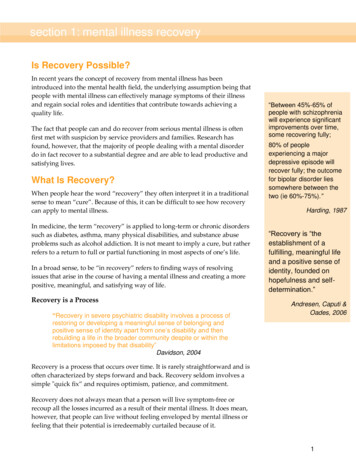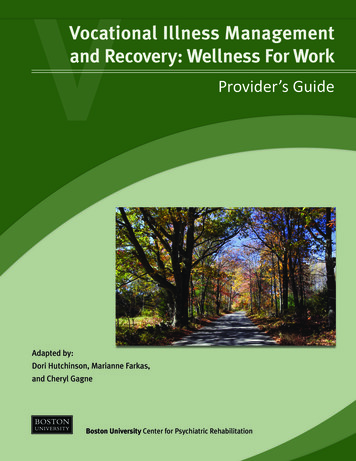
Transcription
VVocational Illness Managementand Recovery: Wellness For WorkProvider’s GuideAdapted by:Dori Hutchinson, Marianne Farkas,and Cheryl GagneBoston University Center for Psychiatric Rehabilitation
Vocational Illness Management & Recovery: Wellness for Work Provider’s GuideVIMR is adapted, with permission from:Gingerich, S., & Mueser, K. T. (2010). Illness Management andRecovery Implementation Resource Kit (Revised).Center for Mental Health Services,Substance Abuse and Mental Health Services Administration,Rockville, MD. 2015, Trustees of Boston University, Center for Psychiatric RehabilitationBoston UniversityCollege of Health and Rehabilitation Sciences: Sargent CollegeCenter for Psychiatric Rehabilitation940 Commonwealth Avenue West, 2nd floorBoston, MA 02215www.cpr.bu.edu/The production of the Vocational Series in Psychiatric Rehabilitation and Recovery was directedby Marianne Farkas.The contents of this publication were developed under a grant with funding from the NationalInstitute on Disability, Independent Living, and Rehabilitation Research, and from the Center forMental Health Services Substance Abuse and Mental Health Services Administration, UnitedStates Department of Health and Human Services (NIDILRR grant 90RT5033). NIDILRR is aCenter within the Administration for Community Living (ACL), Department of Health andHuman Services (HHS). The contents of this project do not necessarily represent the policy ofNIDILRR, ACL, HHS, and you should not assume endorsement by the Federal Government.ISBN 978-1-878512-65-92 2015 Trustees of Boston University, Center for Psychiatric Rehabilitation
Vocational Illness Management & Recovery: Wellness for Work Provider’s GuideAcknowledgmentsThe authors wish to acknowledge the efforts of several people who supported the developmentof this VIMR Provider’s Guide.First, we acknowledge the creativity, commitment, and dedication of the authors of the IMRcurriculum, Susan Gingrich and Kim T. Mueser, who developed Illness Management andRecovery (2005), whose work we have built upon in order to create VIMR.Second, we acknowledge the many providers and service recipients of mental health andemployment programs across the United States, who provided us with their feedback,suggestions, and ideas, all of which helped to strengthen VIMR and its implementation. Wecannot list them all, however, we thank all of them for letting us come into their services andtheir lives. Some of these include:Emily MacDonald, Linda Lopez, and Jonette Serinil, Center for Health Care Services,San Antonio, TX.Marbella Bolivar, Roosevelt Glover, Michelle Colderion, and Roy Starks, The Mental HealthCenter of Denver, Denver, CO.Kimberly Brandt-Lama, Bruce Gunzy, and Christopher Gerbasi, The Kennedy Center, Inc.Goodwill of Western and Northern Connecticut, Inc., Bridgeport, CT.David Smith, Patty Driscoll, and colleagues, Seacoast Mental Health Center, Portsmouth,NH.Recovery Center, Services Division, Boston University’s Center for Psychiatric Rehabilitation,Boston, MA.We acknowledge William A. Anthony, Mikal Cohen, and Karen S. Danley, upon whose work webuilt to adapt VIMR.Finally, we acknowledge Sue McNamara and Christine Grace McMulkin, without whose tirelessefforts at editing and proofing, VIMR would not have been completed and published. 2015 Trustees of Boston University, Center for Psychiatric Rehabilitation3
Vocational Illness Management & Recovery: Wellness for Work Provider’s GuideTable of ContentsPages4Overview of Vocational Illness Management and Recovery5Vocational Recovery and Wellness5The Importance of Helping People Set Meaningful Goals6The Core Values of Vocational Illness Management and Recovery6Participants7Logistics8Using the Modules10Overview of Strategies10Cognitive-Behavioral Techniques13Involvement of Significant Others15The Content16Format of the VIMR Sessions17Goal Setting18Developing Effective Practice Assignments19Module 1: Recovery and Vocational Recovery21Module 2: Practical Facts about Mental Health Conditions and Work23Module 3: The Stress Vulnerability Model and Vocational Recovery25Module 4: Using Medication Effectively and Avoiding Drugs and Alcohol forVocational Success27Module 5: Coping with Challenges and Symptoms at Work30Module 6: Coping with Stress at Work33Module 7: Building Social Relationships at Work36Module 8: Preventing Relapses39Module 9: Performing Your Best at Work42Example: Goal Tracking Sheet45Worksheet: Goal Tracking Sheet46References47 2015 Trustees of Boston University, Center for Psychiatric Rehabilitation
Vocational Illness Management & Recovery: Wellness for Work Provider’s GuideVIMR: Wellness for Work – Provider’s GuideThis guide is designed to provide you with the information, strategies, and tools for usingVocational Illness Management and Recovery (VIMR), a modification of the evidenced-basedIllness Management and Recovery (IMR) curriculum that is oriented towards helping peoplewith mental health conditions live well and thrive as they choose, get, and keep meaningfulemployment. It is a practical step-by-step guide for providers.This guide contains the values, principles, and key concepts that are the foundation of usingVIMR, as well as a lesson plan for each for each of the nine modules of curriculum usingjargon-free language, educational worksheets, and additional resources.The guide is meant to support providers to assist people who want to work to achieve wellnessand employment.Overview of Vocational Illness Management and RecoveryVocational Recovery and WellnessVocational Recovery is the personal process of finding purpose, meaning, and enjoyment atwork. Work is an important part of the recovery experience as it provides people with a valuedrole and resources to live their lives as they choose. People who live with mental healthconditions want to work and can work successfully in careers of their choice.Wellness is a critical resource for all people to achieve their life goals. Wellness at work isespecially important because it supports people to thrive and succeed at work. Wellness is alsovery personal and self-defined state of being that encompasses eight dimensions: physical,mental, social, emotional, financial, spiritual, community, and environmental (Swarbrick,2006).The intent of Vocational Illness Management and Recovery (VIMR) is to support the hope andrights of people who have mental health conditions to thrive with wellness in meaningfulwork. It is a curriculum that is flexible and can be personalized to meet people where they arein their vocational recovery. The focus of VIMR is providing people with inspiration,information, and the strategies they want to support their goal of successful employment.Broadly, the goals of VIMR are: Inspire hope that meaningful work is possible. 2015 Trustees of Boston University, Center for Psychiatric Rehabilitation5
Vocational Illness Management & Recovery: Wellness for Work Provider’s Guide Work in partnership with a person to achieve wellness at work. Teach people information and strategies to support their wellness at work.The Importance of Helping People Set Meaningful GoalsPeople who have experienced mental health conditions often have been told to discard theirdreams because the condition will prevent them from accomplishing what they hope for intheir lives. Self-determining meaningful goals, and then accomplishing them, is an essentialpart of recovery.The importance of empowering people to choose, to set, and to work towards their personalgoals of wellness and work is the heart of VIMR. Each module guides the provider to supportpersonal goal setting that is specific, measurable, and achievable. This constant provideractivity helps the person to move forward with success and happiness towards wellness atwork.Core Values of Vocational Illness Management and RecoveryThe core values of VIMR are those upon which recovery-oriented services are based (Farkas2007; Farkas, Gagne, Anthony, et al., 2005). HopeFirst and foremost, the process of leading a person through VIMR involves inspiring hopethat wellness and work is not only a possibility, but that wellness and work are everydayrealities for people with mental health conditions. This message is critical for empoweringpeople to self-direct and self-determine their lives. It is vital that providers of thiscurriculum teach and support people with the attitude that they have confidence thatpeople will work with wellness. Providers are most successful when they feel hopeful thatthe person will achieve their goals, even if the person is pessimistic or lacking in hope. Person OrientationVIMR is based on respect for individuals in recovery, including the notion that people havestrengths, talents, and interests—not just limitations and illness-related characteristics.6 2015 Trustees of Boston University, Center for Psychiatric Rehabilitation
Vocational Illness Management & Recovery: Wellness for Work Provider’s GuideRecovery-oriented providers are interested in people’s strengths, looking for ways toengage them in their interests, and use their talents for recovery. It is important forindividuals in recovery to know that they have strengths, interests, and talents as theyoften have been served in mental health services that are predominantly focused on theirdeficits. Empowering individuals in recovery involves reinforcing and using the individual’sstrengths to help them choose, get, and keep meaningful work. Involving individuals aspeople with the capacity to learn new information, involving them in determining theirwork interests and ideas about the strategies they are interested in learning and using, andhelping people to reflect on things they did well in their previous experience are someways in which the VIMR curriculum focuses on a person orientation. Self-DeterminationIt is essential for providers to support the self-determination of the person they areassisting to achieve wellness at work. Providers recognize that persons with mental healthconditions have a right to choose what goals in wellness and work are important to themand how they want to proceed in achieving these goals. Providers assist and supportpeople in VIMR to make informed choices about the content that is relevant to their goalsand to their experiences. A constant theme in VIMR is providing information, options, andstrategies to expand people’s awareness of options for wellness at work. PartnershipThe spirit of VIMR is that of partnership. The provider and the person work side-by-side inan equal relationship that reflects respect for one another. The provider’s role is tofacilitate and support the person’s use of the information and strategies in their lives andat work. The person feels respected for their expertise and experiences when with theprovider. The person feels supported in his or her decision-making and valued for theirperspectives. The provider also is respectful and aware of cultural values, practices, andattitudes that the person lives by and is inclusive of a person’s cultural worldview.ParticipantsThe IMR program upon which VIMR is based, was developed from a review of empiricallyvalidated approaches to teaching illness management to people with schizophrenia,schizoaffective disorder, bipolar disorder, and major depression (Gingrich & Mueser, 2011;Mueser, et al., 2002). 2015 Trustees of Boston University, Center for Psychiatric Rehabilitation7
Vocational Illness Management & Recovery: Wellness for Work Provider’s GuideSince the original studies, IMR has been tested with a broader group of participants,inpatients, outpatients, and those living independently in the community, including individualsof all races and a wide range of cultures (Gingrich & Mueser, 2011). VIMR was developed forand tested with a wide range of participants working with employment specialists, includingindividuals with mood disorders, psychotic disorders, Post-Traumatic Stress Disorder, andothers.Participants in VIMR can be anyone with a mental health or behavioral health condition whomay be interested in working. Participants do not have to accept their diagnoses to be able touse VIMR. VIMR providers use whatever language to describe their experience that is used bythe participant himself or herself. As is true for IMR, participants do not need to be clean andsober as a prerequisite for their participation in the VIMR program. Participants may or maynot be currently in a vocational rehabilitation program, such as supported employment. Simplybeing interested in working is sufficient. Those who are working with an employment specialistas well, may be better able to use what they learn from VIMR to pursue their goals. This hasnot yet been fully investigated.LogisticsSettingsVIMR can be used in a wide range of settings, wherever the question of work may arise. Thismight include outpatient clinics, day programs, residential programs, supported housingprograms, supported employment programs, case management programs, etc. The sessioncan be provided in any setting that is convenient for the participant and the provider. As withIMR, this could be the participant’s home; or a public setting where privacy and anenvironment free of distractions is possible, such as a religious organization, school, library, orcommunity center.Length and Frequency of SessionsSessions usually are scheduled for 30-60 minutes at a time, based on the participant’spreferences and tolerance. Depending upon whether you are delivering VIMR in a groupformat or an individual format, the timeframe chosen has to do with participant’s level ofengagement and ability to learn the material. Some people have limited attention spans ordifficulty processing information or may have the type of symptoms that make it difficult tofocus for long periods of time. Providers also may find that participants increase theirattention span over time as they become more familiar with the format and the content.8 2015 Trustees of Boston University, Center for Psychiatric Rehabilitation
Vocational Illness Management & Recovery: Wellness for Work Provider’s GuideThe frequency of sessions varies depending upon the participants, their learning style, and theactivities or other interventions with which they are involved. For example, if someone isworking already, sessions may have to be scheduled in the evenings at whatever frequencymakes the rest of daily life possible. For some participants, more frequent sessions at thebeginning of VIMR helps them to learn and retain the information better. For others, weeklysessions may be preferable to provide more time to practice what they have learned betweensessions. The number of sessions per Module also varies by individual participants.Some participants learn better and need information presented in smaller chunks.Consequently, breaking a Module into two or three sessions may be preferable to trying tocover the material in one session. Some participants may need to review and use someModules more than others, depending upon their situation. For example, Preventing Relapsesat Work may be an issue that is difficult enough for a participant, that a provider might find itsrepetition of strategies and practice to be beneficial for the person.Group or Individual SessionsVIMR was developed for use in individual sessions. The benefit of holding one-to-one sessionsis that participants can move at their own pace and use the Modules in the order that mostmakes sense to them and their life circumstances. For example, a participant may find that theModule on Coping with Problems and Persistent Symptoms at Work to be highly relevant totheir struggles, whereas the Module on Practical Facts about Mental Illness and Work may beof less relevance in the moment. Engaging participants in VIMR and maintaining their interestlevels is best done when the Modules can be selected based on preference and relevance.Some agencies, however, have used VIMR in a group setting. As with IMR, the recommendedsize of a group is between four and six participants. A group format can be more economicalfor the agency and can provide participants with more motivation, ideas, and peer supportthan is available in individual sessions. The main disadvantage of group sessions is that thepower of modules that individually reflects the circumstances of the individual, is lost. Somestrategies that may help to reduce this issue, is to form the group with people who are at thesame stage of their vocational recovery—considering work, choosing work, getting work, orkeeping work (Anthony et al., 2002).In addition, holding some sessions individually and holding some in a group may be anotherstrategy to increase the amount of tailoring possible for the individual participant (Gingrich &Mueser, 2011). For example, the Module on Work and Recovery or the Module on PracticalFacts about Mental Illness and Work may be good modules to do in a group, because theypresent basic ideas about this domain, whereas other modules may be done best individually.Another strategy to both use a group format and maintain the benefit of individual sessions,may be to use a group format to provide social support, share coping strategies, and offerencouragement in pursuing personal goals. 2015 Trustees of Boston University, Center for Psychiatric Rehabilitation9
Vocational Illness Management & Recovery: Wellness for Work Provider’s GuideUsing the ModulesVocational Illness Management and Recovery is an educational curriculum. The value of aneducational approach when helping people achieve their recovery goals is that the processimmediately provides a valued role for the person. An educational approach invites the personto be a student rather than a patient, consumer, or client. This approach values the fact thatlearning is a lifelong process that helps people achieve their goals. Learning reflects the hopeand expectation that people will work with wellness.The VIMR modules incorporate engagement, educational, motivational and cognitivebehavioral techniques. Research has indicated that learning is enhanced for persons with thisblended approach (e.g., Meyer, Rose, & Gordon, 2014; Gronneberg, & Johnston, 2015).Engaging strategies, motivational, educational, and cognitive-behavioral strategies are used inthe VIMR program to engage a person in the VIMR process, enhance a person’s participationand progress through the VIMR, and to assist the person to apply knowledge and skills gainedin the VIMR program in his or her life.Overview of StrategiesEngaging people in a mutual partnership involves using excellent communication skills.Actively listening to people and reflecting back what the provider has heard, demonstratesrespect for the person. Responding to a person’s feelings with empathy conveys a message ofcompassion that helps build trust. Sharing observations in a balanced manner with anemphasis on person’s strengths assists them to develop their confidence and hope. Persistingin reaching out to people who struggle to attend their sessions, also conveys the message thatthey are important and they are valued. Connecting consistently demonstrates to people thattheir participation is important. Reminding them of their vocational and wellness goals andcoaching them to persist and attend sessions builds hope, resiliency, and self-determination.Motivational StrategiesMotivational strategies are included in VIMR. These strategies address the fundamentalquestion of why the person wants to learn, to work, and to live with wellness. If a person doesnot view learning certain information or skills as relevant to his or her needs, that person willnot be motivated to invest in the necessary effort of learning and using new strategies.Motivation should never be assumed and lack of motivation should never be used to shame orjudge a person. Motivation can be developed, and it also can wax and wane. Providers assist10 2015 Trustees of Boston University, Center for Psychiatric Rehabilitation
Vocational Illness Management and Recovery (VIMR), a modification of the evidenced-based Illness Management and Recovery (IMR) curriculum that is oriented towards helping people with mental health conditions live well and thrive as they choose, get, and keep meaningful employ
